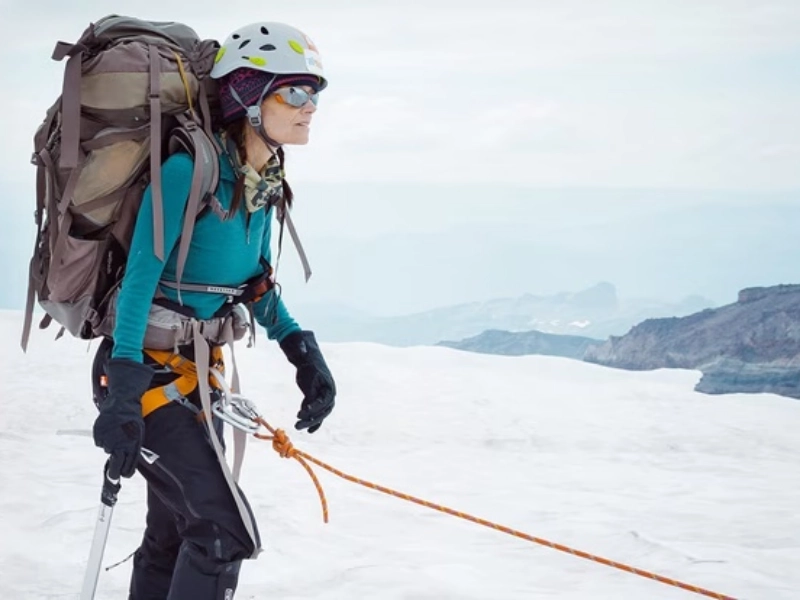Because climbing is such a hard sport, overuse injuries are a possibility. Muscle imbalances, such as the larger and stronger front shoulder and chest muscles compared to the back shoulders and rotator cuff muscles, are frequently the cause of these ailments. Injuries can be avoided by training correctly and having rest days to address these muscular imbalances. Also, injury prevention can be achieved by emphasizing strength training that incorporates both static and dynamic stretching.
 Moving the body through a range of positions that call for the use of distinct muscles is what climbing entails. These muscle groups may get overworked or strained without a thorough warm-up, which could lead to an injury. A proper warm-up improves blood flow, lubricates joints with synovial fluid, and primes the body for strenuous action.
Adapting the warm-up to the needs of the session is important. A lengthy pumping route in the morning, for instance, might be ideal for warming up endurance climbs, but it wouldn't be suited for a power-based workout.
Stretching with movement and modest cardio should be part of the warm-up. Dynamic stretching mimics certain movement patterns utilized in climbing while harnessing the body's natural movement potential to create warmth. To extend your shoulders dynamically, try swinging them five times each way in big, controlled circles forward and backward.
Moving the body through a range of positions that call for the use of distinct muscles is what climbing entails. These muscle groups may get overworked or strained without a thorough warm-up, which could lead to an injury. A proper warm-up improves blood flow, lubricates joints with synovial fluid, and primes the body for strenuous action.
Adapting the warm-up to the needs of the session is important. A lengthy pumping route in the morning, for instance, might be ideal for warming up endurance climbs, but it wouldn't be suited for a power-based workout.
Stretching with movement and modest cardio should be part of the warm-up. Dynamic stretching mimics certain movement patterns utilized in climbing while harnessing the body's natural movement potential to create warmth. To extend your shoulders dynamically, try swinging them five times each way in big, controlled circles forward and backward.
 The muscles and tendons are subjected to an amazing amount of force when climbing. Combined with repetitive motions, this might result in overuse injuries. This may eventually even result in more severe injuries, like tendinitis in your hands or a subluxation of the shoulder.
The key to preventing these ailments is to stretch. Stretching and warming up all of the major muscle groups is crucial. The best way to accomplish this is with dynamic stretching.
Dynamic stretches are best performed right before you begin climbing since they simulate the movement of climbing. After climbing, you should also stretch slowly and statically to help your body heal and become more flexible.
The muscles and tendons are subjected to an amazing amount of force when climbing. Combined with repetitive motions, this might result in overuse injuries. This may eventually even result in more severe injuries, like tendinitis in your hands or a subluxation of the shoulder.
The key to preventing these ailments is to stretch. Stretching and warming up all of the major muscle groups is crucial. The best way to accomplish this is with dynamic stretching.
Dynamic stretches are best performed right before you begin climbing since they simulate the movement of climbing. After climbing, you should also stretch slowly and statically to help your body heal and become more flexible.
 Rotation is a major part of climbing, so having strong, flexible muscles is necessary. Because strength training increases muscle endurance, it can help prevent injuries.
Because climbers frequently hold their arms over their heads for extended periods of time, they are susceptible to rotator cuff issues. This strains the shoulder excessively and, if not reinforced, may result in tendon tears. These kinds of injuries can be avoided by strengthening the shoulders with workouts like military presses or overhead presses.
Strength in the forearm and grip are also very important when climbing. Exercises like twist curls and wrist rotations can help develop the muscles in your hands, forearms, and fingers. For the purpose of controlling your body and keeping your balance while climbing, core strength is also essential.
Rotation is a major part of climbing, so having strong, flexible muscles is necessary. Because strength training increases muscle endurance, it can help prevent injuries.
Because climbers frequently hold their arms over their heads for extended periods of time, they are susceptible to rotator cuff issues. This strains the shoulder excessively and, if not reinforced, may result in tendon tears. These kinds of injuries can be avoided by strengthening the shoulders with workouts like military presses or overhead presses.
Strength in the forearm and grip are also very important when climbing. Exercises like twist curls and wrist rotations can help develop the muscles in your hands, forearms, and fingers. For the purpose of controlling your body and keeping your balance while climbing, core strength is also essential.
 When climbing mountains, it's important to wear the right equipment. Wearing clothing that breathes well and is lightweight will help you climb comfortably without getting too hot. Additionally, it's critical that your clothing is flexible and has sufficient movement.
A pair of soft woolen gloves, for instance, will keep you warm while enabling you to handle ropes and ice axes with good dexterity. Your head and face will be better shielded from the chilly wind by wearing a quality winter hat and gaiters.
A backpack for carrying your gear, carabiners, and tools for rescuing people from crevasses are further necessities. On a mountain, you will most likely require a map and compass to navigate the terrain. Trekking poles are also recommended for added stability and balance.
When climbing mountains, it's important to wear the right equipment. Wearing clothing that breathes well and is lightweight will help you climb comfortably without getting too hot. Additionally, it's critical that your clothing is flexible and has sufficient movement.
A pair of soft woolen gloves, for instance, will keep you warm while enabling you to handle ropes and ice axes with good dexterity. Your head and face will be better shielded from the chilly wind by wearing a quality winter hat and gaiters.
A backpack for carrying your gear, carabiners, and tools for rescuing people from crevasses are further necessities. On a mountain, you will most likely require a map and compass to navigate the terrain. Trekking poles are also recommended for added stability and balance.
 Whether it's a month-long excursion or a quick climbing trip, thorough planning and preparation will help you stay safe and prevent accidents. To make sure you are ready for anything, make sure you have all of your necessary equipment, including ice axes.
A thorough training program can help climbers who participate in the activity on a regular basis lower their risk of injury. This will enhance their climbing ability, lower the risk of damage, and shorten the time they must take off from climbing while they heal.
Having a group or companion with you is another crucial aspect of mountain safety. Having a support network will guarantee that, in the event of an accident or injury, you can get medical attention quickly. They can provide you with first aid and guidance on how to take care of the illness.
Whether it's a month-long excursion or a quick climbing trip, thorough planning and preparation will help you stay safe and prevent accidents. To make sure you are ready for anything, make sure you have all of your necessary equipment, including ice axes.
A thorough training program can help climbers who participate in the activity on a regular basis lower their risk of injury. This will enhance their climbing ability, lower the risk of damage, and shorten the time they must take off from climbing while they heal.
Having a group or companion with you is another crucial aspect of mountain safety. Having a support network will guarantee that, in the event of an accident or injury, you can get medical attention quickly. They can provide you with first aid and guidance on how to take care of the illness.